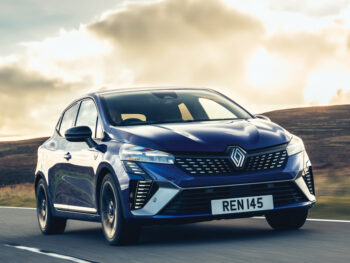Road Test: Renault Clio E-Tech hybrid
More than three decades on, the Clio is back with upgrades inside and out. John Challen gets behind the wheel.

The Clio is back with upgrades inside and out
WHAT IS IT? Hybrid hatchback HOW MUCH? £21,295 (£17,795 petrol) ECONOMY? 67.3mpg EMISSIONS? 96g/km
In an automotive landscape that is increasingly dominated by SUVs, it’s refreshing to see small cars still holding their own. The likes of the Ford Fiesta might have gone, but with the Clio, Renault certainly believes it has a vehicle in demand.
Heading inside the Clio, there’s a mix of technology and sustainability to be admired. The former includes elements such as wireless smartphone connectivity and a multimedia screen up to 9.3-inch, complemented by either a 7-inch or 10-inch dashboard display. There’s also – for the first time in a Clio – heated seats and steering wheel, as well as automatic air conditioning. Finally, Clio’s Multi-Sense technology can adjust the ambient lighting to suit the driver’s mood. In terms of sustainability, there’s no leather in the interior; surfaces instead using TEP, a grained coated fabric made of bio-sourced and polyester fibres.
Externally, there’s been a moderate makeover – including a new lighting setup – but the big difference is under the bonnet. Here, drivers have the choice of two powertrains: a 1.6-litre three-cylinder engine with 90hp and 160Nm of torque or a full hybrid setup with 145hp and 144Nm. We sampled the latter, powered by a willing 1.6-litre 95hp engine, a 1.2kWh lithium-ion battery and two electric motors, which help to achieve a claimed best fuel economy return of 67.3mpg (WLTP). Emissions are quoted as 96g/km. Renault says that, when driving in cities, the electric motor will be deployed up to 80% of the time. The result is a reduction in fuel consumption by up to 40%, compared with a conventional petrol-engined equivalent Clio.
All models in the three-grade lineup (more on that later) feature the likes of lane keep assist, hill start assist, traffic sign recognition and cruise control with speed limiter. Meanwhile, depending on the trim level, drivers can add in blind spot warning, auto high/low beam technology and adaptive cruise control.
Due to the high level of standard equipment on each of the grades, there are no packs for drivers to add on. The range starts with Evolution, running on 16-inch wheels and featuring the likes of full LED lights, cruise control and rear parking sensors. Step up to the Techno model and there are 17-inch alloys, more interior storage, wireless connectivity and front sensors and a rear camera. Topping off the range is the Esprit Alpine with bespoke 17-inch wheels, heated steering wheel, the larger touchscreen display and adaptive cruise control.
Part of the appeal about the Clio is its functional and sensible design when it comes to the layout of the controls. Physical buttons help, but it’s not a fussy appearance. The seats are also some of the most comfortable and supportive we’ve encountered, too! On the road, progress is smooth and the hybrid system works very effectively, which is likely to please those working in urban environments. The rear seat area isn’t the most spacious but, on the whole, there’s a lot to like with the latest French offering.
IN BRIEF
Key fleet model: E-Tech Techno
Pros: Seat comfort; interior layout; performance
Cons: Rear seat space; ride quality
Seven-word summary: Over 30 years on, Clio’s still strong
Also consider: Hyundai i20 / Škoda Fabia / Toyota Yaris












